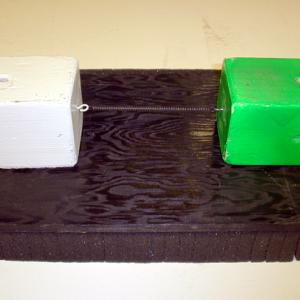College of Liberal Arts & Sciences
1G20.40 - Springs & Weights or Bucket & Elastic
Connect the two blocks with the spring and spread them apart to the ends of the shelf. This leaves the spring under tension but the blocks do not move together because of the friction. Lift the shelf and everything on it and drop it onto the foam pad. As it drops, the spring will pull the blocks together as there is no friction during freefall.
Stretch the elastic string so that the tennis balls hangs over the edge of the bucket. Hold the bucket up high, drop it, and then catch it about waist high. You will observe that immediately after you release the bucket and it achieves freefall, the tennis balls will be pulled back into the bucket by the elastic.
- Morton Tavel, "Reference Frames", TPT, Vol. 41, #4, Apr. 2003, p. 197.
- Jeffrey C. LaCombe and Matthew B. Koss, "The Make-It-Yourself Drop-Tower Microgravity Demonstrator", TPT, Vol. 38, #3, Mar. 2000, p. 143.
- John A. McClelland, "Simulating Microgravity", TPT, Vol. 38, #6, Sept. 2000, p. 328.
- Howard Pearlmas, Dennis Stocker, Daniel Gotti, David Urban, Howard Ross, and Thomas Sours", TPT, Vol. 34, #3, Mar. 1996, p. 172.
- S. K. Chakarvarti, "A Demonstration on Weightlessness", TPT, Vol. 16, #6, Sept. 1978, p. 391.
- Noel J. Petit and Philip A. Johnson, "Uniform Acceleration Demonstration", AJP, Vol. 47, #3, March 1979, p. 287.
- Ken Zetie, "Dieting Isn't The Only Way To Lose Weight", Physics Education, Vol. 39, #1, Jan. 2004, p. 37.
- Julius Sumner Miller, Q52 & A52, Millergrams I – Some Enchanting Questions for Enquiring Minds, p. 37 & 95.
Disclaimer: These demonstrations are provided only for illustrative use by persons affiliated with The University of Iowa and only under the direction of a trained instructor or physicist. The University of Iowa is not responsible for demonstrations performed by those using their own equipment or who choose to use this reference material for their own purpose. The demonstrations included here are within the public domain and can be found in materials contained in libraries, bookstores, and through electronic sources. Performing all or any portion of any of these demonstrations, with or without revisions not depicted here entails inherent risks. These risks include, without limitation, bodily injury (and possibly death), including risks to health that may be temporary or permanent and that may exacerbate a pre-existing medical condition; and property loss or damage. Anyone performing any part of these demonstrations, even with revisions, knowingly and voluntarily assumes all risks associated with them.

